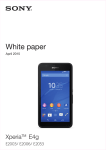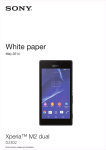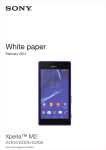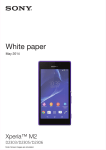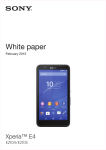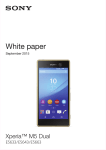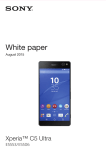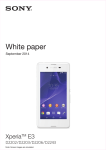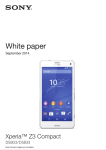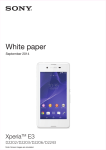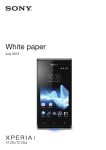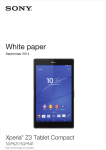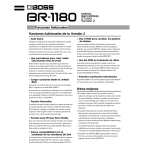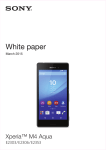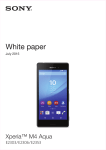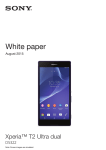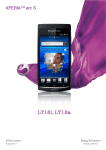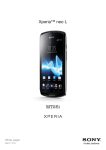Download Sony Xperia E4g 8GB 4G White
Transcript
White paper March 2015 XperiaTM E4g E2003/ E2006/ E2053 White paper | Xperia™ E4g Purpose of this document Sony Mobile Communications product White papers are intended to give an overview of a product and provide details in relevant areas of technology. NOTE: The illustration that appears on the title page is for reference only. All screen images and elements are subject to change without prior notice. Document history Version February 2015 First released version Version 1 February 2015 Second released version Version 2 March 2015 Third released version Version 3 Sony Mobile Developer World For the latest technical documentation and development tools, go to www.sonymobile.com/developer. This document is published by Sony Mobile Communications Inc., without any warranty*. Improvements and changes to this text necessitated by typographical errors, inaccuracies of current information or improvements to programs and/or equipment may be made by Sony Mobile Communications Inc. at any time and without notice. Such changes will, however, be incorporated into new editions of this document. Printed versions are to be regarded as temporary reference copies only. This White paper is published by: Sony Mobile Communications Inc., 1-8-15 Konan, Minato-ku, Tokyo108-0075, Japan www.sonymobile.com © Sony Mobile Communications Inc., 2009-2015. All rights reserved. You are hereby granted a license to download and/or print a copy of this document. Any rights not expressly granted herein are reserved. *All implied warranties, including without limitation the implied warranties of merchantability or fitness for a particular purpose, are excluded. In no event shall Sony or its licensors be liable for incidental or consequential damages of any nature, including but not limited to lost profits or commercial loss, arising out of the use of the information in this document. First released version (2015) 2 March 2015 White paper | Xperia™ E4g Table of contents Product overview ........................................................................................................2 Highlights ...............................................................................................................2 Product Specifications ..........................................................................................3 Categorised feature list ..........................................................................................6 Technologies in detail .................................................................................................9 Device-to-device communications (local) .............................................................9 Bluetooth® wireless technology .........................................................................9 Wi-Fi® ...............................................................................................................10 DLNA Certified® (Digital Living Network Alliance) ............................................11 Messaging ...........................................................................................................12 MMS (Multimedia Messaging Service)..............................................................12 Email .................................................................................................................12 Positioning – location based services .................................................................13 Provisioning (OMA CP) ........................................................................................13 Multimedia (audio, image and video) ...................................................................14 Synchronisation (OMA DS, EAS, Google Sync™) ...............................................15 Web browser .......................................................................................................15 Memory in Android™ devices .............................................................................16 Trademarks and acknowledgements ..................................................................20 1 March 2015 White paper | Xperia™ E4g Product overview Highlights • • • • 4G speed Long-lasting battery and Battery STAMINA mode High quality images and video: 5 MP camera with HD 1080p video Ultra fast performance: MediaTek MT6732 Quad-Core 1.5 Ghz processor and 1 GB of RAM The speed with 4G Enjoy the fastest news and information downloads, find your way using maps, check and send email, send pictures to friends and family in seconds, and make the most of trouble-free online music streaming on the go. Superior battery If you lead a busy family and professional life, you will enjoy an impressive 2-day battery life (under normal usage conditions) even when you don't activate the extra power-saving options. You can talk, email, text, navigate or do anything else you usually do with your smartphone as you move through your day. Switch on STAMINA mode and see by how much you just extended your battery life. Battery STAMINA mode optimises how your battery is used. When you’re not using the display, apps and functions that work in the background get turned off, but you’ll still receive calls, texts, alarms and your choice of app notifications. To get everything up and running again, just press the power key. A camera that thinks for you Whether you're trying to capture special family moments or reunions with friends, the Xperia™ E4g dual will make your pictures great. Featuring a 5 MP main camera with autofocus and flash as well as a 2 MP front camera, the device is packed with Sony camera technology and has a wide range of optional image enhancing apps built in. Autoscene Recognition technology senses the visual atmosphere, recognises 52 different scenes, and then selects the ideal settings automatically to give you the best possible picture of where you are. 2 March 2015 White paper | Xperia™ E4g Product Specifications Operating system Google™ Android™ 4.4.4 (KitKat) Processor 1.5 GHz MediaTek MT6732 Quad-core GPU ARM Mali-760 MP2 Size 133 x 71 x 10.8 mm Weight 135 grams Available colours Black, White Main screen Colours 16,777,216 colour TFT Resolution 540x960 pixels Size (diagonal) 4.7 inches Scratch-resistant Yes - Durable tempered glass Input mechanisms Text input On-screen QWERTY keyboard, 12-key input Touch screen Capacitive Touch gesture Yes – multi-touch, up to 4 fingers supported Handwriting recognition Yes Memory RAM 1 GB Flash memory Up to 8 GB* Expansion slot microSD™ card, up to 32 GB Camera Camera resolution 5 MP Digital zoom 4x Video recording Yes – HD 1080p Front Camera Yes – HD 720p for video chat and 2 MP for camera capture Sensors Accelerometer Yes Ambient light sensor Yes Proximity sensor Yes 3 March 2015 White paper | Xperia™ E4g Networks E2003 UMTS HSPA+ 900 (Band VIII), 850 (Band V), 1900 (Band II), 2100 (Band I) MHz GSM GPRS/EDGE 850, 900, 1800, 1900 MHz LTE Bands 1, 2, 3, 5, 7, 8, 20 E2006 UMTS HSPA+ 850 (Band V), 1700 (Band IV), 1900 (Band II), 2100 (Band I) MHz GSM GPRS/EDGE 850, 900, 1800, 1900 MHz LTE Bands 2, 4, 5, 7, 12, 13, 17 E2053 UMTS HSPA+ 850 (Band V), 900 (Band VIII), 1700 (Band IV), 1900 (Band II), 2100 (Band I) MHz GSM GPRS/EDGE 850, 900, 1800, 1900 MHz LTE Bands 1, 2, 3, 4, 5, 7, 8, 28 Data transfer speeds GSM GPRS (upload and download) Up to 85.6 kbps GSM EDGE (upload and download) Up to 237 kbps UMTS HSUPA (upload) Cat. 6, up to 5.76 Mbps UMTS HSDPA (download) Cat. 24, up to 42.2 Mbps LTE (upload) Cat. 4, up to 50 Mbps LTE (download) Cat. 4, up to 150 Mbps Battery performance Talk time (GSM) Up to 12 hours 42 min.** Standby time (GSM) Up to 779 hours** Talk time (UMTS) Up to 13 hours 17 min.** Standby time (UMTS) Up to 752 hours** Standby time (LTE) Up to 606 hours** Music listening time Up to 64 hours 46 min.** Video playback time Up to 6 hours 57 min.** Battery (Embedded) 2300 mAh, minimum * Memory comprises approximately 2.5 GB of firmware, plus 4.8 GB of “Internal Storage” for music, pictures and movies, and downloaded applications and their data. For more details about memory, see “Memory in Android™ devices” on page 16. ** Values are according to the GSM Association Battery Life Measurement Technique as performed in controlled laboratory conditions. Actual time may vary. 4 March 2015 White paper | Xperia™ E4g NOTE: Battery performance may vary depending on network conditions and configurations, and device usage. NOTE: Performance metrics are measured under laboratory conditions. 5 March 2015 White paper | Xperia™ E4g Categorised feature list Camera Music Search 5 MP camera 4x digital zoom Auto scene recognition AR Effect AR Fun Creative effects Face detection Face in Flash/Photo light Geotagging HDR for pictures Image/Video stabiliser Live on YouTube™ - by Xperia™* Multi camera (Only available for E2003) Movie creator Object tracking Portrait Retouch Quick Launch Red-eye reduction Scene recognition Self-timer Send to web Smile Shutter™ Sound Photo Social live* Sweep Panorama Timeshift burst Touch capture Video recording (HD 1080p) White balance 3D Surround Sound (VPT) Album art Bluetooth® stereo (aptX®, A2DP) ClearAudio+ Clear Bass™ Clear Phase™ Clear stereo Dynamic normaliser Manual equaliser SensMe™ TrackID™ music recognition* Walkman® application xLoud™ Experience Bookmarks Google Chrome™* Google Play™ Google™ search* Google Voice™ Search* Google Maps™ for Mobile with Street view* Web browser (WebKit™)* 6 March 2015 White paper | Xperia™ E4g Communication Messaging Design Answering machine* Call list Conference calls Facebook™ application* Google+* Hangouts™* HD voice support Loud Speaker Noise suppression Speakerphone Voice enhancement Xperia™ Socialife* Conversations Email Google mail™* Handwriting recognition Instant messaging Multimedia messaging (MMS) Predictive text input Text messaging (SMS) Auto rotation Battery STAMINA mode Gesture input Illumination effect On-screen 12-key keyboard On-screen QWERTY keyboard Picture wallpaper Screen capturing Simple UI Throw Touch screen Ultra STAMINA mode Voice input * This service is not available in all markets. Entertainment Organiser Connectivity Media browser PlayMemories* Radio (FM radio with RDS) SensMe™ slideshow Sony Entertainment Network** YouTube™* Airplane mode Alarm clock Calculator Calendar Contacts Setup guide Sketch Stopwatch Timer 3.5 mm audio jack (CTIA) aGPS* Bluetooth® 4.1 wireless technology Cast screen DLNA Certified® GLONASS Media Go™* Media Transfer Protocol support Micro USB support Native USB tethering Media Go™* NFC (Only available for E2003) PC Companion Screen mirroring Smart Connect Synchronisation via Facebook™ Synchronisation via Google™ Synchronisation via Microsoft® Exchange ActiveSync® Synchronisation via SyncML™ USB charging USB High speed 2.0 support USB mass storage Wi-Fi® Wi-Fi® Hotspot functionality 7 March 2015 White paper | Xperia™ E4g * This service is not available in all markets. ** Sony Entertainment Network with Music Unlimited is not available in every market. Separate subscription required. Additional terms and conditions apply. 8 March 2015 White paper | Xperia™ E4g Technologies in detail The information presented in this section is a general overview of the technology incorporated into the product. However, hardware and software levels of compliance to standards and specifications vary between products and markets. For more information, contact Sony Mobile Developer World or the relevant Sony representative. Device-to-device communications (local) Bluetooth® wireless technology Bluetooth® profiles supported Advanced Audio Distribution Profile v1.2 Audio /Video Remote Control Profile v1.5 Hands Free Profile v1.6 Human Interface Device Profile Headset Profile v1.2 Message Access Profile v1.0 Object Push Profile v1.1 Personal Area Networking Profile Phone Book Access Profile v1.1 SIM Access Profile v1.1 Core version and supported core features Version 4.1 Other supported features aptX® CD quality audio streaming over Bluetooth® connection Connectable devices Products that support at least one of the profiles listed above. Bluetooth 4.1 accessories generally require installation of a supporting application. More information: www.sonymobile.com/developer www.bluetooth.com 9 March 2015 White paper | Xperia™ E4g Wi-Fi® Supported standards IEEE 802.11 a/b/g/n and Wi-Fi® Wi-Fi Direct®, Wi-Fi Protected Setup, Wi-Fi CERTIFIED Miracast™ Connectable devices Wi-Fi® access points Wi-Fi Direct® compatible devices Frequency band 2.4 GHz and 5 GHz Data transfer rate Up to 150 Mbit/s Security Open Authentication Shared Authentication EAP-SIM EAP-AKA EAP-TLS EAP-TTLS/MSCHAPv2 PEAPv0/EAP-MSCHAPv2 PEAPv1/EAP-GTC WPA Personal and WPA2 Personal WPA Enterprise and WPA2 Enterprise Encryption WEP 64 bit, WEP 128 bit, TKIP and CCMP (AES) Power save WMM-UAPSD QoS WMM 10 March 2015 White paper | Xperia™ E4g DLNA Certified® (Digital Living Network Alliance) Supported Device Classes M-DMS – Mobile Digital Media Server Media Types: image, video and music Summary: The digital media server exposes the media files in your device to a Wi-Fi® network. The files can then be accessed from other DLNA Certified® clients. M-DMP – Mobile Digital Media Player Media Types: image, video and music Summary: Play content stored on another device, for example, a server or a PC, directly on your device. M-DMC – Mobile Digital Media Controller Media Types: image, video and music Summary: Digital Media Controllers find content offered by a DMS or M-DMS and match it to the rendering capabilities of a DMR — setting up the connections between the DMS and DMR. +PU+ Media Types: image, video and music Summary: Play media in your device on another device, such as a TV or a PC using 2 box push technology. +PU+ is integrated in the Album, Movies and Walkman® applications. +DN+ Media Types: image, video and music Summary: Download content stored on another device, for example, a server or a PC, and play the downloaded content directly on your device. +UDO+ Media Types: image, video and music Summary: The digital media server also has the capability to get uploaded files from other DLNA Certified® clients. Supported Bearers Wi-Fi® Wi-Fi Direct™ DRM Support The DLNA Certified® implementation does not support DRM-protected content. 11 March 2015 White paper | Xperia™ E4g Messaging MMS (Multimedia Messaging Service) According to OMA Multimedia Messaging Service v1.0 + SMIL Email Bearer type (IP) GPRS, EGPRS, UMTS, Wi-Fi®, LTE Character sets BIG5 Traditional Chinese GB2312 Simplified Chinese GB18030 ISO-2022-JP Japanese ISO-8859-1 ISO-8859-2 Eastern Europe ISO-8859-5 Cyrillic ISO-8859-7 Greek ISO-8859-9 Turkish ISO 8859-11 KOI8-R Cyrillic Shift_JIS Japanese USASCII UTF-16 UTF-8 Windows® 874 Windows® 1251 Cyrillic Windows® 1252 Windows® 1254 Turkish Windows® 1258 Vietnamese Protocols POP3 and IMAP4 Push email Microsoft® Exchange ActiveSync® (EAS) Secure email SSL/TLS, both port methods (POPS/IMAPS) and STARTTLS HTML mail Yes (read only) More information: www.sonymobile.com/developer www.openmobilealliance.org 12 March 2015 White paper | Xperia™ E4g Positioning – location based services Supported standards: • OMA Secure User Plane Location (SUPL) v1.0 • 3GPP™ Control Plane location (including Emergency location), only supports E911 Provisioning (OMA CP) OMA CP version 1.1 13 March 2015 White paper | Xperia™ E4g Multimedia (audio, image and video) Audio Playback Audio Recording Image Playback Image Capture Video Playback Decoder format Supported in file format Audio decoding MPEG-1/2/2.5, audio layer 3 MP3 (.mp3), 3GPP (.3gp), MP4 (.mp4, .m4a) AAC, AAC+, eAAC+ 3GPP (.3gp), MP4 (.mp4) AMR-NB, AMR-WB 3GPP (.3gp), MP4 (.mp4) General MIDI (GM) SMF (.mid) Linear PCM 16 bit WAV (.wav) OTA OTA (.ota) Ogg vorbis Ogg vorbis (.ogg) WMA ASF (.wma) Encoder format Supported in file format AMR-NB, AMR-WB 3GPP (.3gp), MP4 (.mp4), AMR (.amr) AMR-NB, AMR-WB, AAC-LC stereo Sample rate: 49 kHz Bit rate: up to 128 kbps 3GPP (.3gp), MP4 (.mp4) Decoder format Supported in file format 1, 4, 8, 16, 24 and 32 bpp and RLE encoded formats BMP (.bmp) Single and multi-frame, bitmap mask support (GIF87a format and GIF89a format) GIF (.gif) Joint Photographic Experts Group JPEG (.jpg) Portable Network Graphics Bitmap mask support PNG (.png) Webp Webp (.webp) Encoder format Supported in file format Joint Photographic Experts Group JPEG (.jpg) Decoder format Supported in file format MPEG-4 Visual Simple Profile 3GPP (.3gp), MP4 (.mp4) H.264 3GPP (.3gp), MP4 (.mp4) H.263 Profile 0 3GPP (.3gp) 14 March 2015 White paper | Xperia™ E4g Video Recording Audio/Video Streaming Encoder format Supported in file format - Video H.263 Profile 0, H.264 High Profile - Audio: AAC-LC stereo Bit rate: 10 Mbps AMR-NB 3GPP (.3gp), MP4 (.mp4) Streaming transport RTSP according to 3GPP™ HTTP streaming Synchronisation (OMA DS, EAS, Google Sync™) OMA Data Synchronisation protocol versions 1.1.2 and 1.2 OMA Data Formats: vCard 2.1, vCalendar 1.0 Microsoft® Exchange ActiveSync® protocol version 2.5 Microsoft® Exchange ActiveSync® protocol version 12.0 Microsoft® Exchange ActiveSync® protocol version 14.0 Microsoft® Exchange ActiveSync® protocol version 14.1 Google Sync™ Related information: www.sonymobile.com/developer Web browser Google Chrome™ for Android™ is pre-installed in markets/regions where no restrictions apply. Related information: https://play.google.com/store/apps/details?id=com.android.chrome 15 March 2015 White paper | Xperia™ E4g Memory in Android™ devices To use Android devices efficiently, users should be aware of the different types of device memory. This knowledge is important in order to understand, for example, where data such as music, photos and videos is saved; how many apps can be downloaded from Google Play™; and how photos can be copied to a PC. Information regarding memory presented in this section may be useful to developers when optimising applications for mobile devices. Generally, all Android devices share the same basic memory setup. What differs is how much memory is available to you via the different types of memory, and whether your device uses an external SD card or an internal memory chip. Any information specific to the particular device model described in this White Paper is noted as such. Types of memory The types of memory described and numbered below are consistent with the terminology used in Sony mobile device menus and in other content relating to 2015 Xperia™ devices: 1. Dynamic Memory (also known as RAM) is used by applications that run when the device is turned on. The amount of Dynamic Memory influences how many applications and operating system services can run at the same time. The Android operating system automatically closes applications and services that are not being used. However, such automatic functionality has limits. For example, if a lower amount of free RAM is available to applications after a new release of the operating system (due to increased capabilities in the system), device speed will eventually be impacted. This is the main reason that a device cannot be indefinitely upgraded to newer releases of Android™. If you experience problems with RAM, for example, if the device runs slower than usual or if the Home application restarts frequently when you leave an application, you should minimise the use of apps that run all the time. Social networking apps that connect and update their data online and animated backgrounds are examples of apps that are always running and affect RAM performance. To minimise RAM issues, you could also consider using a static wallpaper instead of a live wallpaper. To see which apps and services are currently active, go to Settings > Apps > Running. You should have at least 100 MB, and ideally 200 MB or more, of free RAM to avoid slowdowns and application restarts. You should also be aware that if you update the device to a later Android release, the load on the builtin Dynamic Memory will increase due to the addition of more features. As a result, the device may run slower after an update. The Xperia™ E4g has 758 MB of RAM available to the Android OS and any installed applications. 350 MB of the total RAM is in use during normal operation when the user starts using the device out of the box. 2. System Memory (also known as “System partition” or “/system”) is used for the Android OS and for most applications that are pre-loaded from the factory. This type of memory is normally locked, and can only be changed through a firmware upgrade. There is usually some free space available in this section of memory. However, since it is locked, you cannot save apps, photos or any other content to this memory. System Memory is reserved for future firmware upgrades, which almost always need more memory than the original firmware. You cannot see or influence the use of this memory. 16 March 2015 White paper | Xperia™ E4g 3. Internal Storage is referred to as "working" memory. It can be compared to the C: drive on a PC or to the startup disk on a Mac. This type of memory is used to store all application downloaded from the Google Play™ Store (and other sources) as well as their settings and data (such as emails, messages and calendar events, for example). All applications have an allocated area for application data. Memory dedicated to an application is inaccessible to other applications. Some game applications also store content such as game music and game level information outside their own designated area. In most cases, an application can choose to save its data in a location of its own choosing (outside the protected application settings area). Generally, such content is not deleted when an application is uninstalled; it must be removed manually by connecting the device to a computer with a USB cable, or by using a file manager application. Internal storage is also used for all added user content. For example, photos taken using the device's camera, media files downloaded from the Internet and file transfers are stored in this area. Typical user content includes: • photos • movies • music • Email attachments Internal Storage will tend to fill up as a result of normal usage. Devices with a large initial Internal Storage can handle more applications and store more user content. If the Internal Storage starts to get full, the device slows down, and in some cases it might no longer be possible to install more apps. You should always ensure that you have at least 100 MB of free Internal Storage. If not, you should consider removing some apps that you seldom use, or move content that you do not frequently access to external storage. You can see approximately how much Internal Storage is free in Settings > Storage > DEVICE MEMORY. You can also view more details about how much memory is used by applications under Settings > Apps. In the Xperia™ E4g, about 4.8 GB of Internal Storage is available out of the box. Please note that in Sony Mobile 2015 products, “Internal Storage” is now the combination of what was previously known as “Device Memory” or “Phone Memory” (for applications and their data – also previously known as “/data”) and “Internal Storage” (for user’s content – also previously known as “/ sdcard”). The changes in Internal Storage were made so that memory usage could be more flexible and to allow encryption of user content. Memory card slot Some products include both a large internal memory and a built-in memory card reader. Android manages devices with a built-in memory card reader and internal memory differently from a device that includes only a built-in memory card reader. Since most applications expect only a single location for storage, such applications will not generally allow you to SAVE anything to the memory card (i.e., they do not offer the option to choose a storage location). However, some applications (for instance, the Sony Mobile “Camera” application) may actually allow you to do so. Other applications, for example, backup applications such as the Sony Mobile “Memory” application, will by definition be configured to copy content from the Internal Storage to the external SD card. 17 March 2015 White paper | Xperia™ E4g On the other hand, when it comes to reading from an external SD Card, you will be able to access content (for example, videos, photos and music) on a memory card inserted in this slot without any special consideration since the Android system searches all available memory for content. Therefore, such products may be regarded as supporting a fourth type of memory, called “External Card” or “SD Card”. 4. SD Card (known as “/ext_card” from a programmer’s point of view, or by other names in other Android products) is the name for the removable SD memory card in all 2015 Sony Mobile products. As described in the previous section, this External Card memory is generally more limited in that any application can read from it, but many applications cannot save to this card. Only a few applications, including backup applications and file manger applications, have the capability to save to this card. Backing up data to different memory types Generally, you should not save photos, videos and other personal content solely on the internal memory of a device. If something should happen with the hardware, or if the device is lost or stolen, the data stored on the device’s internal memory is gone forever. In a device where an SD card reader is the main memory, it is relatively easy to take the card out and copy all content to a PC or Mac, or to an entertainment device with a memory card slot. In a product featuring Internal Storage as the main memory, it is not possible to physically remove the memory. Instead, any critical or high-value content must either be copied to an external SD card by a special backup application, transferred to remote storage over a network (mobile or Wi-Fi), or to a computer via a USB cable. To facilitate the transfer of data via a cable, the Xperia™ E4g supports Media Transfer Protocol (MTP), which makes it possible to easily transfer content back and forth between your device and a Windows® PC. For Apple™ Mac® computers, a special application called Sony™ Bridge for Mac is available with built-in support for MTP. This application can be downloaded from the Xperia™ E4g support page. Note that you do not need to back up or make a copy of applications that you have downloaded from the Google Play™ Store. They can normally be downloaded again after you have set up your Google account to work in a new device (or in a device where the memory has been completely erased). Note 1: Some Android devices, including Sony Mobile devices from 2012 and Sony Ericsson devices from 2011 and earlier, do not use a single “Internal Storage” for both applications (and their data) and user content. Instead, these devices use either an external SD card for user content, or a corresponding area of internal memory to reproduce the functionality of an SD card. In such devices, there is a fixed limit between the application area (“/data”) and the user content area (“/sdcard”), with the result that user content can build up and reach this limit. When the user content reaches this limit, no additional data can be added using any application. For example, the camera application would no longer be able to capture additional photos even if a considerable amount of free space was available in the application area. This limit also applies to the application area. Downloading and installing new applications would not be possible even if there was enough free memory in the user content area. Note 2: Some devices with integrated storage have abandoned the distinction between the application area and the content area when it comes to a Factory Data Reset. As a result, there is no option in such devices to perform a Factory Data Reset and preserve content. In such devices, all content is completely deleted from the device when a reset is performed. In contrast, Sony Mobile’s memory integration solution makes it possible to preserve user content in this situation. Therefore, when performing a Factory Data Reset, the default action will still be to only remove applications and their data, and an option box must be checked if all content is to be removed as well (as might be desirable when selling the device second-hand). 18 March 2015 White paper | Xperia™ E4g Note 3: For a developer, it is important to note that from a programming point of view the location names used to refer to the different memory areas described in Note 1 are still valid, i.e., the area used for applications (“/ data”) is still present, as is the area used for content (“/sdcard”). In reality, “sdcard” is a “symbolic link” to “/data/media”. However, from inside an Android application, “/ sdcard” can still be used. For example, you can use “sdcard/DCIM/100Android” to find all camera images. The continued use of “/sdcard” to access the content area ensures compatibility across different products and Android releases in this regard. 19 March 2015 White paper | Xperia™ E4g Trademarks and acknowledgements All product and company names mentioned herein are the trademarks or registered trademarks of their respective owners. Any rights not expressly granted herein are reserved. All other trademarks are property of their respective owners. Visit www.sonymobile.com for more information. 20 March 2015






















